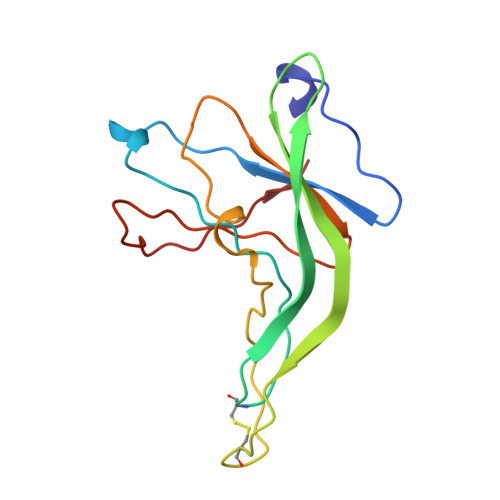The role of ecotin dimerization in protease inhibition.
Eggers, C.T., Wang, S.X., Fletterick, R.J., Craik, C.S.(2001) J Mol Biol 308: 975-991
- PubMed: 11352586
- DOI: https://doi.org/10.1006/jmbi.2001.4754
- Primary Citation of Related Structures:
1IFG - PubMed Abstract:
Ecotin is a homodimeric protein from Escherichia coli that inhibits many serine proteases of the chymotrypsin fold, often with little effect from the character or extent of enzyme substrate specificity. This pan-specificity of inhibition is believed to derive from formation of a heterotetrameric complex with target proteases involving three types of interface: the dimerization interface, a primary substrate-like interaction, and a smaller secondary interaction between the partner ecotin subunit and the protease. A monomeric ecotin variant (mEcotin) and a single-chain ecotin dimer (scEcotin) were constructed to study the effect of a network of protein interactions on binding affinity and the role of dimerization in broad inhibitor specificity. mEcotin was produced by inserting a beta-turn into the C-terminal arm, which normally exchanges with the other subunit. While the dimerization constant (K(dim)) of wild-type (WT) ecotin was found to be picomolar by subunit exchange experiments using FRET and by association kinetics, mEcotin was monomeric up to 1 mM as judged by gel filtration and analytical centrifugation. A crystal structure of uncomplexed mEcotin to 2.0 A resolution verifies the design, showing a monomeric protein in which the C-terminal arm folds back onto itself to form a beta-barrel structure nearly identical to its dimeric counterpart. The kinetic rate constants and equilibrium dissociation constants for monomeric and dimeric ecotin variants were determined with both trypsin and chymotrypsin. The effect of the secondary binding site on affinity was found to vary inversely with the strength of the interaction at the primary site. This compensatory effect yields a nonadditivity of up to 5 kcal/mol and can be explained in terms of the optimization of binding orientation. Such a mechanism of adaptability allows femtomolar affinities for two proteases with very different specificities.
Organizational Affiliation:
Departments of Biochemistry and Biophysics, University of California at San Francisco 94143-0446, USA.














